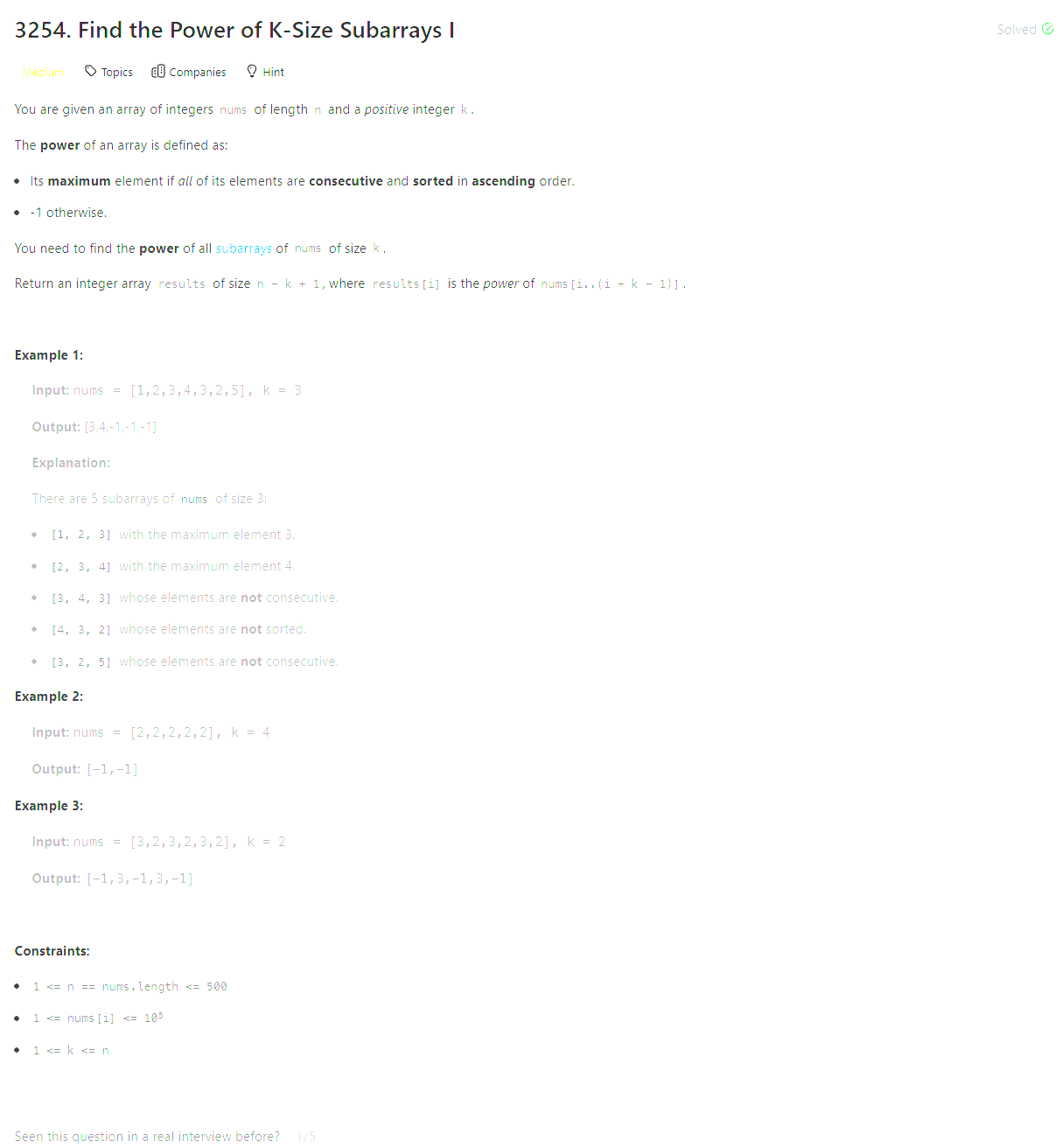Problem of The Day: Find the Power of K-Size Subarrays I
Problem Statement

Intuition
The goal of the algorithm is to identify segments of the input list nums of size k where all elements form a continuous sequence. A continuous sequence is defined as a sequence of integers that start from a value x and increase by 1 consistently. For each valid segment, the last element of the sequence is added to the result. If the sequence is not valid, -1 is appended instead.
Approach
- Sliding Window: To process the list efficiently, the algorithm uses a sliding window of size
k. This allows checking all subarrays of sizekin linear time relative to the size of the array. - Validation: Each subarray is validated using the
isValidmethod. This method checks if the subarray forms a continuous sequence by iterating through its elements. - Building Results: If the current window is valid, the last element of the window is added to the result. Otherwise,
-1is appended. - Iteration: The window slides forward by incrementing the left (
l) and right (r) pointers until the right pointer reaches the end of the array.
Complexity
-
Time Complexity:
- The outer loop runs \(O(N - k + 1)\) times, where \(N\) is the length of the array.
- The
isValidfunction iterates over each window of sizek, making the total complexity \(O(N \cdot k)\). - Overall: \(O(N \cdot k)\).
-
Space Complexity:
- The algorithm uses a list
resto store the results, which has a size proportional to \(O(N - k + 1)\). - Overall: \(O(N)\).
- The algorithm uses a list
Code
class Solution:
def resultsArray(self, nums: List[int], k: int) -> List[int]:
l, r = 0, k
N = len(nums)
res = []
while r <= N:
if self.isValid(nums[l:r]):
res.append(nums[r - 1])
else:
res.append(-1)
l += 1
r += 1
return res
def isValid(self, arr):
curr = arr[0]
for x in arr:
if curr != x:
return False
curr += 1
return True
Editorial
Approach 1: Brute Force
class Solution:
def resultsArray(self, nums: List[int], k: int) -> List[int]:
length = len(nums)
result = [0] * (length - k + 1)
for start in range(length - k + 1):
is_consecutive_and_sorted = True
# Check if the current subarray is sorted and consecutive
for index in range(start, start + k - 1):
if nums[index + 1] != nums[index] + 1:
is_consecutive_and_sorted = False
break
# If valid, take the maximum of the subarray, otherwise set to -1
if is_consecutive_and_sorted:
# Maximum element of this subarray
result[start] = nums[start + k - 1]
else:
result[start] = -1
return result
- time: O(n * k)
- space: O(1)
Approach 2: Sliding Window with Deque
class Solution:
def resultsArray(self, nums: List[int], k: int) -> List[int]:
length = len(nums)
result = [-1] * (length - k + 1)
index_deque = collections.deque()
for current_index in range(length):
if index_deque and index_deque[0] < current_index - k + 1:
index_deque.popleft()
if (
index_deque
and nums[current_index] != nums[current_index - 1] + 1
):
index_deque.clear()
index_deque.append(current_index)
if current_index >= k - 1:
if len(index_deque) == k:
result[current_index - k + 1] = nums[index_deque[-1]]
else:
result[current_index - k + 1] = -1
return result
- time: O(n)
- space: O(k)
Approach 3: Optimized Via Counter
class Solution:
def resultsArray(self, nums, k):
if k == 1:
return nums # If k is 1, every single element is a valid subarray
length = len(nums)
result = [-1] * (length - k + 1)
consecutive_count = 1 # Count of consecutive elements
for index in range(length - 1):
if nums[index] + 1 == nums[index + 1]:
consecutive_count += 1
else:
consecutive_count = 1 # Reset count if not consecutive
# If we have enough consecutive elements, update the result
if consecutive_count >= k:
result[index - k + 2] = nums[index + 1]
return result
- time: O(n)
- space: O(1)